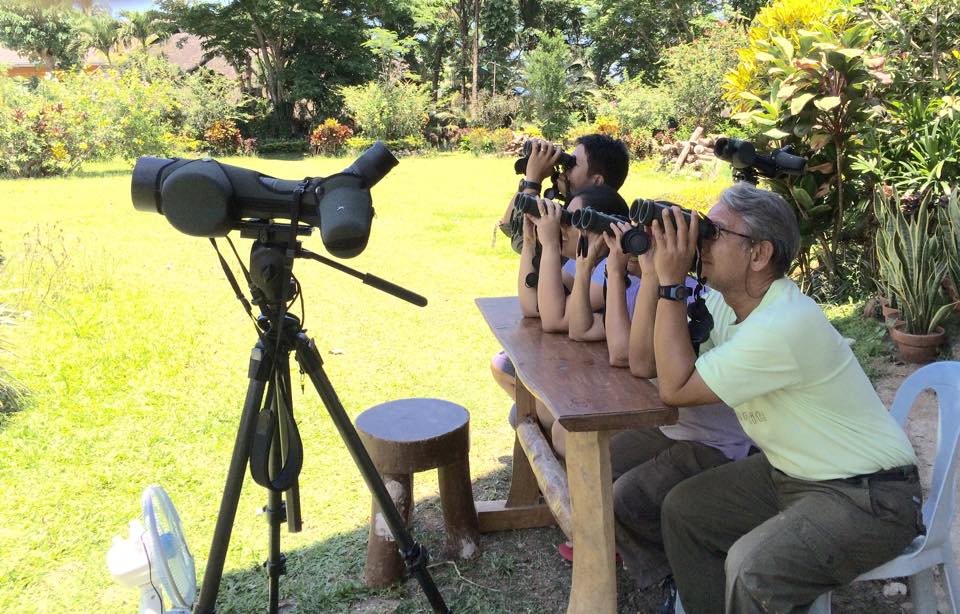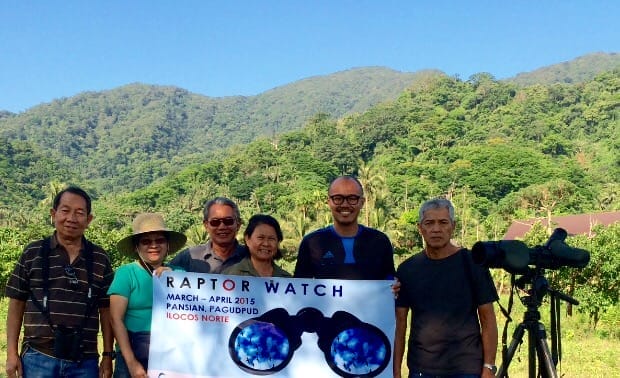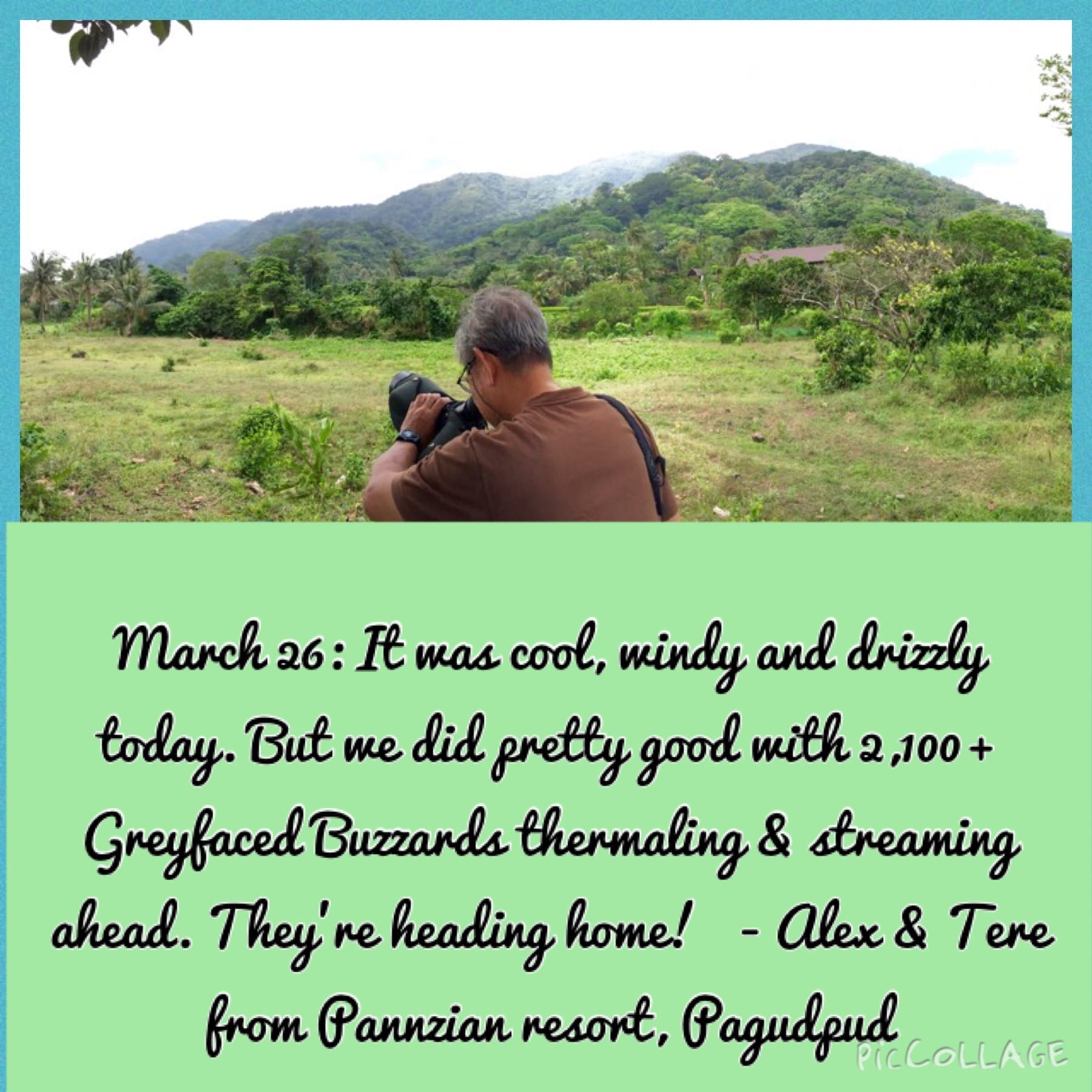by Alex Tiongco and Tere Cervero of the WBCP Raptor Group
The Philippines has been known to be a black hole of information on migratory raptors in terms of species, numbers and habitat and routes. In order to address the situation, for the last 4 years, the WBCP Raptor Group has been exploring the raptor migratory flyways in the Philippines. Among others, the following initial discoveries were made:
1) A spring roosting area for Grey-faced Buzzards at Cagayan Valley.
2) An obligatory spring converging flyway and lands-end at Ilocos Norte. The discovery was made only in spring this year (2015) and it is deemed necessary to continue regular counts and studies in this area to be able to create a data base for numbers and species of raptors that winter and/or pass through the Philippines from the Palaearctic.
The following article is an unpublished report of the Spring Migration Watch conducted at Pannzian Beach and Mountain Resort in 2015
NORTHERN LIGHT
2015 Spring Raptor Migration count
Location: Pannzian Beach & Mountain Resort, Brgy. Pancian, Pagudpud Ilocos Norte
Duration: March 12, 2015 to April 25, 2015
Background
For the last three years, the raptor group had been exploring the northern regions on Luzon to look for flyways and exit points of migratory raptors. All explorations, brief as they might have been, yielded great results pointing to Pagudpud as a major route, if not the exit point itself. This year (2015) the group decided to watch at Pagudpud for the whole migratory season. However, a proper watch point/site was still to be located.
It was decided that the location of an appropriate watch point/site would have to be found during the migratory season itself which was the best time for an actual chase as the raptors move about their migratory paths.
The watch was scheduled for 6 weeks from the middle of March to the end of April which was envisaged to cover the peak periods of migration for both the Chinese Sparrowhawks and the Grey-faced Buzzards – the two most common migrant raptor species in the Philippines.
The first 7 days (14-20 March) of the project after our arrival at Pagudpud were spent locating a suitable watch site based on our previous observations on the area for the last two spring migration times, information from local residents and actual sightings whilst locating a possible watch site.
The following areas were visited:- The entrance of Barrio Caunayan, the town of Caunayan, Pagudpud’s land’s ends at Stingray Memorial, the entrance of Barrio Balaoi facing the north end of the Patapat Mountains, the zipline tower of Hannah’s in Balaoi, the beach line of Pannzian Beach Resort, the municipality of Adams, a small plateau along the boundaries of Barrio Adams and Pancian and finally an area east of Pannzian Beach Resort which is designated as Pannzian Beach Ecopark.


The Pannzian Beach Ecopark was chosen to be the most suitable site because it afforded the best view of the Patapat Mountains which is believed to be one of the main lead lines for the northward exit of raptors during spring migration.


The Site – a crossroad for raptors leaving for mainland Asia and for Taiwan
The Ecopark is part of the ricebowl valley between the Kalbario and Patapat Mountains, with 3 rivers running though it. To the west of the valley is the Patapat Mountains of which the highest peak at 1300 masl called “Pico de Loro”, to the south are the mountains of Adams, to the east is the Kalbario Mountains, to the north is Pasaleng Bay which opens up to the mainland Asia to the north west and Taiwan to the north east.
Strong thermals are produced in the valley when the sun is up, especially during the rice planting season when the rice paddies are filled up with water, and the surrounding mountains produce updrafts generated by the northeast monsoon during spring migration. Pannzian Beach Ecopark is located right at the Raptor project’s home base and on our first day of watch there on March 21 with Doc. Pete Calope, Dennis Jakoboski and Michael Calaramo. We spotted 1,109 Grey-faced Buzzards – the most counted during the search for a watchsite.
All the other areas visited produced good sightings which proves that the Kalbario-Patapat ranges are a Raptor Migration Spring flyway but on these places, either the raptors were too far or the panorama is too limited. Adams however deserves further investigation.


The watch is generally from 6 AM to 2 PM. It was noticed that after 12 noon sightings are meager and with no other volunteer watchers to takeover, it was considered prudent to stop our watch because the sun would be mercilessly in our faces and after 7 hours of being absolutely peeled, our eyes would have been painted electric blue and the remains of our brains dysfunctional.
Additionally, we have learned from our contacts at Kenting, Taiwan that in crossing the sea between Taiwan and the Philippines, raptors migrate only from 5AM and 2 PM. We therefore consider raptors sighted after 2 PM to be roosters to be counted when they fly again the following day.
The watch was conducted towards the end of the Northeast monsoon season and the winds were north and northeast, hovering around 5 KPH and never exceeding 17KPH. The temperature was consistently cool at from 26 degrees centigrade at the start of the watch to about 32 degrees centigrade after noon. The sky was generally cloudless but the peak days were generally cloudy. Barometer readings average 1010.

Grey-faced Buzzard
The peak hours for the Grey-faced Buzzards are from 9AM to 11 AM. Early flights (6-7AM) are low and directionless except for one very cloudy day with strong winds hitting the mountain 1,300 individuals took flight.
The Grey-faced Buzzards were observed everyday from the start of the watch until the end. Their peak period for this season was from 21 March to 29 March with > than 1,000 individuals a day. The highest count for this species in one day was 8,528 on 23rd March; next highest at 6,834 on 28th March.
This species was observed everyday from the start of the watch until the end. Towards the end of the migratory season, April – they were no longer in great hurry and would thermal over a certain point for long periods, one period was for 45 minutes. Many of them were seen perched and hunting. A pair was seen flying in close formation over a small area and landing on several occasions on various days. We cannot confirm whether it is the same pair or different pairs.
The general direction of flight for the Grey-faced Buzzard early in the count (from March 14 to 27) was from south, southwest heading towards northeast and east northeast. Some birds would follow the Mt. Patapat lead lines southwards and upon reaching the southernmost part of the range, would thermal over the valley and head northeast
However with the appearance of a large flock of the Chinese Sparrowhawks on March 28, which was flying west and northwest, the direction of the Grey-faced Buzzard flights became Northwest as well.
Then, their flight patterns changed yet again after the passage of Typhoon Maysak on April 5. From April 6 onwards, all early flights (5:45AM up to 10 AM), were headed northwest. After 10 AM all flights were headed Northeast.
For the northeast flyers, Grey-faced Buzzards were seen coming from behind the Patapat Mountains mostly from the southwest flying northeast. The most popular thermaling area is the northface of Pico de Loro and over the valley on the southernmost part of Mt. Patapat. For those heading northwest they would come from the southeast, behind and southwest of Patapat ranges and thermal on the northface of Mt. Patapat, then head over the sea.
Chinese Sparrowhawk
Because of their great similarity, all small accipiters are counted as Chinese Sparrowhawks unless we are reasonably satisfied that it is a Japanese Sparrowhawk, of which we can confirm only 3 individuals. Since Besra do not migrate nor flock, this species is not considered.
An aberrant flock of Chinese Sparrowhawk was seen furiously flying from the east headed towards the northface of Pico de Loro, thermalled there and proceeded northeastwards over the sea. After that nothing much was seen until significant numbers were noted again commencing 13th April, peaked on 19th April (12,283) and 21st April (6,468) and died down considerably after.
The peak hours for the Chinese Sparrowhawks are from 6:30 to 8:00 with very little sightings after 8:00 AM. This leaves a very narrow but intensive avenue for counting this species.
The direction of flight for the Chinese Sparrowhawks is invariably Northwest . The Chinese Sparrowhawks come from the southeast, south and the southwest of the Patapat.
Great flocks were also observed coming from the Kalbario Mountains east of the watch heading towards Pico de Loro. As observed in the previous years, those seen coming from the Kalbario Mts originate from Sanchez Mira, Claveria and Sta, Praxedes – Cagayan Valley.
It is significant to note that there were less Chinese Sparrowhawks counted here for spring – 34,812 –than were counted last autumn at Sarangani – 47,308. This shows that there could be other exit points here at Northern Luzon.

Other Species of migrant raptors
Western Osprey – 33
Most Western ospreys were seen heading north northeast and only 2 were seen heading northwest.
Crested Honeybuzzard – 48
All of these birds were seen heading northeast. All those that were seen were not dark in coloration.
Black Kite – 1
This raptor was seen floating about coming from behind the Mt. Patapat but eventually thermalled at the northface of the Patapat and headed northwest.
Peregrine Falcon- 5
All Falcons were seen heading northeast.
Small Falco sp.-10
Unfortunately we are not familiar with the I.D. of this species. They were flying high, fast and far and none were seen at close range.
The following Sedentary Raptors were observed in the area which shows that the Kalbario-Patapat National Park is an important and intact biodiversity area:-
Philippine Serpent Eagle
White-bellied Sea eagle
Philippine Hawk-eagle
Rufous-bellied Hawk-eagle
Philippine Honey Buzzard
Brahminy Kite
Notes From Alex and Tere’s Raptor Diary
Home Base
The “Northern Light Raptor House” is at Pannzian Beach & Mountain Resort, Brgy Pancian, Pagudpud. Ken Alonso, the resort owner volunteered to be part of the project and offered free accommodations for the WBCP watchers (maximum of 4 members) for the duration of the watch. We slept at the attic of the Raptor House.

The Watchers
Alex Tiongco
Tere Cervero
Ken Alonso
Felix Servita
Trinket Constantino
Adri Constantino
Jude Sanchez
Patty Adversario
Louie Perez
Doc Pete Calope
Richard Ruiz
Dennis Jakoboski
Michael Calaramo
Barangay Captain Arnel Faylogna & local residents
Mang Boy Ochavo
Efren Boado
Mayor Eric Bawigan
Dra. Biel Waley-Bawigan – Ecology and Tourisim officer
Julian Albano – DENR park ranger
Victor Davalos – DENR Cenro
Samson Amistad – Pagudpud Chief of Police
Pagudpud Chief of Staff
Chinese consul Zhao Qiaoliang and his wife





Other non-raptor migratory species
Chestnut-cheeked Starling – 20 stopped to feed on a fruiting tree at the Pannzian ecopark
Frigate bird sp. – 1 (most likely Lesser Frigate Bird) which stormed in from the sea one day, after a strong squall.
Some Highlights
April 01: Early morning flights were right on schedule, higher and more swiftly this time towards the Northwest.
Most of the day was cloudless with 5kph wind and was therefor uneventful. Peak time was 9-10am. Thermals were very slow. A dogfight between a Phil Serpent-eagle and a Rufous-bellied Hawk-eagle which was disrupted by a White-bellied Sea Eagle and an earthquake at 12:08pm provided some adrenalin rush.
April 3: As if on cue the early fliers appeared at 5:50am. Some proceeded Northwest ; others perched on the foothills of the Patapat Mountains. For the first time since we’ve been watching them, we heard them cry out “tikwi, tikwi”. Our lifer for bird calls. Flights were a bit early today with the peak hour being the 8-9am watch. Flight direction was generally to the Northwest direction since the appearance of Chinese Sparrowhawks on the 28th of March. However, some individuals still fly East-northeast, especially the big raptors (OHB, Osprey). We saw 2 GFBs coming from the East with badly broken wing feathers, flying with much difficulty – 1 amongst a flock and the other going solo. Casualties of hunting?
The highlight for today is the female Japanese Sparrowhawk which all of a sudden swooped into a tree across the ricefield and perched, giving us good views. This is our first Japanese Sparrowhawk since we started the watch.
April 16: The day started early as usual and slow. The early Greyfaced Buzzards flew from the south and the east to the northface of Mt. Patapat and disappeared there.
Temperatures for the day was from 25 – 32 degrees Centigrade; wind from the east and northeast constantly between 5-7 kph, cumulous clouds covered from 60-90% of the skies: relative humidity hoverd from 66-72 and brometer pressure 1014hpa.
The peak of the day was at the 9-10 AM watch when 6 large kettles of Chinese Sparrowhawks tornadoed through the skies.
There were 2 instances when some small kettles suddenly broke up with the raptors scattering whichever way. We could not understand it at first but on the second occasion, Boy saw that a Rufous-bellied Hawk-eagle came attacking the kettle.
There were many Greyfaced Buzzards that came down to land on the nearby hill an stayed perched for a long time, and many thermalled on the same area for over 40 minutes as if unwilling to leave.
The highlight of the day was the appearance of the Black Kite! And today was the first break in slow counts for the Chinese Sparrowhawks with 4,170 individuals. We were so happy, we had to celebrate with 2 rounds of German Wheat Beer in a pub at Saud owned by a German Master Chef.

April 19: More friends were due to arrive- The Chinese consul and wife and Doc Pete. The skies were ready for the day with wall to wall cumulus-cirrus clouds. Adri was still in the room, and all the rest had coffee and bun in the garden to watch out for early fliers. Doc Pete and company were on the way. The Greys were early as usual.
At 6:20 Tere went back to the house when it happened. A Chinese was spotted by Trinket thermaling over Mt. Patapat and she followed it to a big tornado which was connected by a long raptor river snaking its way to anther tornado over head.
Tere and Adri and other people in the resort came running out to watch the flickering ticker tape spectacle. A lot more kettles were noticed from the east heading northeastwards. In just over 2 hours, it was over – 11,254 Chinese Sparrowhawks! At 8:15AM Doc Pete and company came just to catch the tail end. After 10AM, no more CS came.
Running total migratory raptors as of April 25, 2015:
Location: Ecopark of the Pannzian Beach & Mountain Resort
Pagudpud, Ilocos Norte
Osprey 33
Oriental Honey-buzzard 48 (1 resident)
Black Kite – 1
Grey-faced Buzzard 27,657
Chinese Sparrowhawk 34,812
Japanese Sparrowhawk 3
Peregrine Falcon 5
Small Falco sp. 10
Unidentified Large raptor sp. 5
Total migratory raptor individuals counted: 62,574


Keep up your GREAT effort hope to join you soon